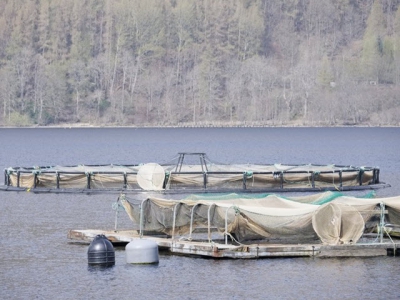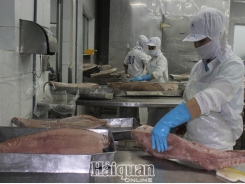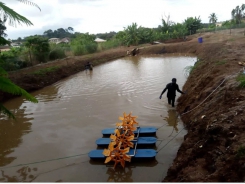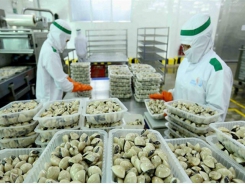Researchers testing feed premix effectiveness in sea lice control

A new £300K (US$373.5K) study involving researchers from the Institute of Aquaculture (IoA) at the University of Stirling, Scotland and a UK animal feed manufacturer is aiming to explore how certain feed ingredients can reduce infections in farmed fish.
The IoA is collaborating with the Devon-based feed producer, Denis Brinicombe Group, which manufactures feed products for the ruminant and equestrian markets, on what will be a three-year long project.
Sea lice in salmon is the central focus.
The partners will test the theory that modified aquaculture diets that include Brinicombe’s patented bioactive compound premix will have a positive impact on the health of farmed fish by reducing infection rates, survival and reproductive output of sea lice.
Lead investigator, Dr Armin Sturm, senior lecturer, IoA, said that while some of the veterinary drugs used to control sea lice can affect other marine organisms and may accumulate in marine sediments, the feed product the team will be testing is non-toxic and short-lived in the environment.
If effective, such feed ingredients could add to the growing arsenal of non-medicinal control strategies currently employed to tackle sea lice infections, he said.
“Any companies that have something they might want to test against sea lice that seems to be promising is very much in our interest,” Sturm told FeedNavigator, when asked about the prompt for this particular project, which is funded by the Denis Brinicombe Group, Innovate UK, and the Biotechnology and Biological Sciences Research Council, through a Knowledge Transfer Partnership.
Commercial sensitivities prevented him from going into detail about the exact composition of the feed product being tested, but preliminary industry trials using Brinicombe’s premix in another fish species showed encouraging results, he said.
“We will check the efficacy of the product in salmon and look at whether it has any effect on [a range of] performance parameters, to see if it prevents infections or helps the fish get rid of infections. Potential customers for such a product want to be reassured that it is well tolerated by the fish, that it does not impact any performance parameters,” said Sturm in relation to the type of testing that will take place under the three-year project.
The cost of this method of tackling sea lice infections would need to be on par with other approaches to render it effective, he added.
Keith Greig, MD of Brinicombe, said the company is hoping to establish, through this project, that its feed technology is transferable to the aquaculture market, and that it will be transformational for an industry that is battling an increasing parasitic population.
He said the feed manufacturer has used its anti-parasitic technology for several years with good success in large animals globally, recently seeing breakthroughs in the poultry sector.
Sea lice challenge
Sea lice are a persistent problem for the European salmon industry.
Sea lice infections can adversely affect farmed fish performance by reducing appetite and growth, and compromising the animal’s immune responses, potentially leading to secondary infections.
While having an adverse effect on productivity and animal welfare, sea lice can also lead to wider environmental impacts, and such parasite load reduces the level of social acceptance for salmon farming.
Companies like Norwegian salmon producer, Mowi, have been exploring new production concepts that move fish farms out of the fjords and down into the ocean depths so as to protect the fish from sea lice, disease and the weather.
The use of cleaner fish for biological delousing of salmon in large-scale production conditions and technologies that modify the design of cages are other approaches used in sea lice control.
“There are quite a number of methodologies available now. Hopefully, sea lice management is [going to become less challenging],” continued Sturm, who has spent many years evaluating drug resistance in sea lice.
“We know these parasites are very adaptable. What we need to look at is the combination of or rotation of different approaches to treat the fish or prevent infections, to make it more difficult for the parasite to adapt to controls.”
Yeast strains ‘one tool in the fight against lice’
The use of in-feed functional compounds and yeast cell wall fractions against such parasites has shown some mixed results to date, said Lallemand in an interview with this publication in December 2018.
Eric Leclercq, aquaculture technical support and R&D manager, Lallemand Animal Nutrition, told us then that the company tested a single-strain yeast fraction (SsYF) product on Atlantic salmon post-smolt performance, sea lice settlement and skin mucosal barrier.
The company had received feedback from farmers that the single strain yeast fraction, rich in mannan-oligosaccharides, worked well; they could see benefit, he said.
“However, sometimes it is good to go to the basics, and we wanted to keep confirming that it works on specific applications.”
When asked what the indicator was that the yeast fraction might reduce susceptibility of Atlantic salmon to sea lice, he said:
“We know there is some level of immune interaction in the host as regard this product, given that it is a yeast fraction, so there will be some level of defense again pathogens. The key reason we thought the single strain could help in terms of a sea lice challenge infection was based on previous experiments backed up by customer feedback.
“Sea lice is big problem; functional feeds tend to fall below the radar when it comes to sea lice, but the benefits of functional feeds, in this regard, is that there is continuous impact, much like cleaner fish, they can be used throughout a cycle, preventively, to minimize sea lice infection, hopefully,” he stressed.
A 10-week tank-based trial was conducted in Scotland using Atlantic salmon post-smolts, testing the effects of the single-strain yeast fraction product, on sea lice at two (chalimus stage) and four weeks (motile stage) post-challenge.
Specific growth rate was numerically improved for fish fed the functional diet, showing significantly fewer settled chalimus compared to the control. Furthermore, the diet was associated with a significant or trend increase in skin mucus quantity and lysozyme activity, he said.
The data also supported the positive contribution of a SsYF product on the growth, skin mucosal barrier and mitigation of lice settlement in Atlantic salmon, he added.
“We saw no negative impact of the product on growth, a very good finding. We see a higher level of skin mucus quantity, an increase in the secretion of mucus on the skin of the fish. Two weeks after the sea lice challenge, we found less chalimus on the fish. Four weeks later, the lice move onto the adult stage, and we saw a lower lice level.”
The trial then, he said, showed accumulative benefits against lice propagation over the rearing cycle - continuous usage of the product saw ongoing reduction over successive lice waves.
The single strain yeast fraction, he stressed, is just one tool, however, in the fight against lice, but it may have the effect of minimizing the frequency of heavier interventions such as veterinary treatment, a chemical bath, or mechanical delousing.
Related news
Tools

Phối trộn thức ăn chăn nuôi

Pha dung dịch thủy canh

Định mức cho tôm ăn

Phối trộn phân bón NPK

Xác định tỷ lệ tôm sống

Chuyển đổi đơn vị phân bón

Xác định công suất sục khí

Chuyển đổi đơn vị tôm

Tính diện tích nhà kính

Tính thể tích ao




 Analyst: Salmon farming needs sector sea lice solutions…
Analyst: Salmon farming needs sector sea lice solutions…  China opens market to three Vietnamese aquatic products
China opens market to three Vietnamese aquatic products